Contents
- 1. Smrutis
- 2. Religious scriptures (Dharmashastra)
- 3. Content
- 4. Necessity
- 5. Importance
- 6. Special features
- 7. Number
- 8. Differences between the Smrutis
- 9. Important Smrutis
- 10. Proof
- 11. Period of composition
- 12. The Vedas (Shrutis) and the Smrutis
- 13. The scriptures and yoga
1. Smrutis
‘The word Smruti is used with two meanings. In the broad sense it can be applied to all the ancient religious texts, excluding the Vedic literature of the post-Vedic period, which profess Sanatan philosophy. These holy texts include Panini’s Vyakaran, the Shrautsutras, Gruhyasutras and Dharmasutras, the Mahabharat and the holy texts by sages such as Manu and Yadnyavalkya. In the narrow sense of the word the Smrutis and the religious scriptures mean one and the same thing.’(1) The religious scriptures are basically of two types, the Smrutis and the Dharmasutras.
‘Though the history of religious scriptures does not include the Gruhyasutras yet a large part of it appears in the Dharmasutras, Smrutis and other holy texts. Since the Dharmasutras are associated with different Vedic branches they are inclined towards the Gruhyasutras of the respective branch. In the Smrutis all the topics are arranged systematically, but in the Dharmasutras they are not. All the Smrutis are in the form of verses (shlokas).
2. Religious scriptures (Dharmashastra)
Righteousness (Dharma) and scriptures are two words. Here the word Dharma is associated with actions. In it, action (karma) is discussed as follows. That action whose result is ultimate benefaction (attainment of the Final Liberation) is righteous and that action whose result is unhappiness or an inferior form of happiness is unrighteous. Now let us try to understand the meaning of the scriptures. Scriptures do not mean science. Holy texts such as the Vedas have been called the scriptures. One Sutra by Sage Vyas is ‘Shastrayonitvat’ (Brahmasutra 1.1.2). The divine birth passage of the scriptures (shastrayoni) may be defined as that from which the scriptures have originated or that which can be realised through the scriptures is Brahman (the Vedas). Also science (shastra) is that which governs (shasan) is another meaning.’(2) ‘शास्तिहिताहित यत् तत् शास्त्रम् ।’ means that in which the advantages and disadvantages are described are called the scriptures. ‘The scriptures were written after contemplation about the welfare of the people. These scriptures initially preach on Righteousness (Dharma), wealth (artha) and desire (kama) and later the Final Liberation (Moksha).’ – Mahabharat 12.335.27-33 and 35
3. Content
‘The Smrutis mainly include description of the code of conduct, worldly transactions and penance for atonement (prayashchitta). The duties according to the class and stages of life (varnashram) are included in the purview of the code of conduct. Accordingly transactions (meting out justice), penance for atonement, Serenity, donation, etc. are topics which are discussed in the Smrutis. Only an individual who becomes cultured after good values (sanskar) are imbibed by him can bring about his own welfare or that of society. This is precisely why ancient sages have created certain spiritual rites (sanskar). Detailed discussion of all these spiritual rites is given in the code of conduct (achar) part of the Smrutis.’(3)
Duties and rights: The Indian scriptures lay greater emphasis on duties than on rights. Duty itself means Righteousness (Dharma). One’s rights are limited to the extent to which they are related to the duties.
4. Necessity
4.1 The changing social scenario
‘The first doctrine advocated by Indian philosophers is that Righteousness is not the end but only a means to bring about progress of the society which is actually its goal. The Mahabharat defines Righteousness (Dharma) as – ‘धारणाद्धर्ममित्याहुर्धर्मो धारयते प्रजा:’. The word Dharma (Righteousness) means to sustain. Since all people are dependent on Righteousness, that itself sustains them. That is why there is a doctrine which says that that which sustains people is Righteousness. Another doctrine generated from this is that since the ultimate aim of Righteousness is upliftment of society one should determine what is the truth and the untruth, what is just and unjust from it. Once the definition that “the regulations responsible for the upliftment of society or a state, mean Righteousness” is accepted, one cannot guarantee that it will remain constant for all times and places. Evolved philosophers from the Mahabharat have emphasised this point elaborately at different junctures. Sage Vyas has clearly specified that the codes of Righteousness in every yug (era) are different. Though the doctrines of Righteousness (Dharma) regarding attainment of the Final Liberation (Moksha) are eternal, those of worldly transactions cannot be the same for all times. Circumstances always undergo change. Accordingly societal restrictions need to be changed. Even Bhishma has stated that Righteousness varies with the time and place. The verse (shloka) is as follows –
स एव धर्म: सोऽधर्मो देशकाले प्रतिष्ठित: ।
आदानमनृतं हिंसा धर्मो ह्यावस्थिक: स्मृत: ।। – महाभारत १२.३६.११Meaning: What is Righteousness at the appropriate time and place proves to be unrighteousness at the inappropriate moment and place. This holds good for theft, speaking the untruth and violence. Righteousness has to be judged according to the situation. – Mahabharat 12.36.11
On another occasion Bhishma has given the following explanation – in times of a crisis one should observe the inferior conduct of Righteousness followed by people under similar circumstances in olden times, because O Bharat (Yudhishthir), the codes of Righteousness in times of prosperity and adversity are different. One can observe righteous conduct even without accumulating wealth. However sustaining oneself in day-to-day life is even more important than Righteousness. Wise men opine that in times of adversity even unrighteousness appears righteous and Righteousness appears unrighteous because there is no guaranteed path to acquire wealth by remaining righteous. On different occasions based on the place, time and circumstances as the nature of Righteousness keeps changing one is faced with this dilemma as to what conduct one should follow under specific circumstances and on what it should be based. If some doctrines on truth, non-violence and compassion were eternal one could make a decision to act according to them, but it is not so. Indian philosophers emphatically state that at times the truth happens to be the untruth and under such circumstances when society is undergoing a crisis if one behaves righteously it leads him to hell (narak) [Karnaparva 69].’(4)
The moral values of righteous conduct substantiated by the Mahabharat are based on analytical rationalism. In it, the stage of ritualistic worship (karmakand) propounded by the Shrutis and Smrutis is deemed inferior.
स्तेयं कुर्वंश्च गुर्वर्थमापत्सु न निषिध्यते ।
बहुश: कामकारेण न चेद्य: संप्रवर्तते ।। – महाभारत १२.३४.२३Meaning: One is not forbidden from stealing for the purpose of offering one’s fees unto the Guru (gurudakshina). However one should not be tempted to do it intentionally several times. – Mahabharat 12.34.23
अन्यो धर्म: समर्थानामापत्स्वन्यश्च भारत ।। – महाभारत १२.१३०.१४
Meaning: (Bhishma tells Dharmaraj) O Bharat (Yudhishthir), the righteous conduct when one has power is quite different from that when one is faced with calamity. – Mahabharat 12.130.14
Since it is difficult to enumerate all the calamities which befall an individual and the society, the religious scriptures cannot predict the righteous conduct to be followed in favourable and unfavourable circumstances.
When studying the discussion on Righteousness (Dharma) given in the Smrutis one realises that Righteousness changes in every yug (era). This change is seen in worldly transactions. The changes in the Vedic code of Righteousness is because of the changes made by Manu and the seven sages (saptarshis) during the manvantar and due to the code of conduct (achar) [1 manvantar is equivalent to 43,20,000 human years. It is a one-fourteenth part of the day of Lord Brahma. In other words one day of Lord Brahma consists of fourteen manvantars. There is a separate Manu for each manvantar. The current manvantar is the seventh one].
4.2 Conflicting worldly and spiritual duties
‘When faced with both these duties simultaneously, which duty one should perform and which one should reject is the distinction between Righteousness and unrighteousness. In general, an average person may be told not to perform that duty which renders him more distress.
A rule may also be framed such that, should there be a clash in the duties arising from the worldly and the spiritual, then the former should be accepted and the latter be rejected. Meditation, worship of and contemplation on God are included in the spiritual duties. If when performing spiritual duties, tasks essential for one’s temperament or means of sustenance arise then they should be accorded priority. Spiritual duties may be kept in abeyance temporarily.
4.3 Conflicting worldly actions
Satisfying hunger is the first among these duties because there is no sorrow greater than starvation. Only when one’s hunger is satiated will a man survive and be able to observe Righteousness; hence satiating one’s hunger is the foremost duty of Righteousness of worldly duties. Other progressively less important duties could be protecting oneself from heat and cold, sleep, medical treatment, etc.’(5)
5. Importance
‘With respect to Righteousness (Dharma) the Smrutis immediately follow the Shrutis as the authority (axiom). The Shrutis just make a reference of the righteous code of conduct. Different Sanhitas include important doctrines relating to marriage and its types, types of sons, the mode of adoption of a son, division of wealth, division of ancestral property, the rite for the departed (shraddha), a woman’s personal property (stridhan), etc. but all this information is found scattered. However it is compiled systematically in the Smrutis. The Smrutis are a vast treasure house of doctrines pertaining to scriptures on Righteousness.’(6)
6. Special features
अनधिगत अबाधित असंदिग्धार्थबोधकं वाक्यं शास्त्रम् ।
Anadhigat (अनधिगत): This means that one will not acquire this knowledge from any other scripture. One is compelled to realise it from this scripture alone.
Abhadhit (अबाधित): This cannot be affected or countered by anything else.
Asandigdharthabodhakam (असंदिग्धार्थबोधकं): Here whatever is prescribed is not vague such as ‘do this or that’ rather is emphatic as ‘do this, do not do this’. These itself constitute the rules and regulations (vidhinishedha).
7. Number
Yadnyavalkya has enumerated twenty Smrutis in his roll of names. In the ensuing period the number of Smrutis enumerated in the holy texts went on rising. Compilers like Kamalakarbhatt, etc. have mentioned the names of approximately 100 Smrutis.
8. Differences between the Smrutis
‘There are many Smrutis but so are the differences in opinion between them. Thus it is automatically established that it is neither possible nor proper that all the terminology from the commentaries (mimansas) of the quotes from the Shrutis and all the regulations from it be applied to decide the code of Righteousness (Dharma). Commentators on the religious scriptures however thrust the technique of finding the middle path (samanvay) which was hitherto absent in the Mimansas and insisted that there should be uniformity and absence of contradiction in all the Smrutis. All the same this is absolutely impossible to achieve. Authors of the Smrutis do not themselves subscribe to this technique of finding the middle path, rather they clearly express their differences of opinion without resorting to this method. To cite an example, the Purvasmruti states that a man belonging to the Brahman (priest), Kshatriya (warrior) or Vaishya (businessman) classes may marry a woman belonging to the Shudra class. However Yadnyavalkya states that he opposes this concept (Yadnyavalkyasmruti 1.56).
Though the Smrutis are authorities by themselves they never had or will have authority devoid of any relativity. Due to differences in place, time, etc. they state different things. When making decisions about Righteousness what one should bear in mind is that with the changing times and places the authors of the Smrutis have altered the codes of conduct.
Basically all the Smrutis have originated from the Vedas. If one is unable to trace the basis of a particular ritual in the Vedas, then it is supposed that it must have been present in the Vedas or their branches which have now ceased to exist. Due to the defects of negligence, laziness, etc. in man and the death of realised souls, according to some authors of scriptures, some Shrutis have been lost over the passage of time. They also insist that the Shrutis which are no longer available now should be treated as the authority for the conduct advocated by the Smrutis. This is but a struggle to obtain authoritarian status for the Smrutis by the Vedas, by some means or the other. However it cannot survive the test of rational intellect.’ (7)
9. Important Smrutis
The Manusmruti is the touchstone of authority if one considers the number of commentaries written on the Smrutis as the parameter for such an evaluation. This is followed by the Yadnyavalkyasmruti. Other Smrutis follow suit in hierarchy.
10. Proof
‘The Vedas are called the Shrutis and the Smrutis are called the scriptures (Dharmashastra) according to a quote by Manu (2.10) “धर्मशास्त्रं तु वै स्मृति:”. However apart from the scriptures holy texts on a variety of topics are also included in the Smrutis. It is customary to also refer to Panini’s Ashtadhyayi, the Mahabharat and the Purans as the Smrutis. Holy texts on Darshans such as the Sankhyas are also referred by the same name. Should all such Smrutis be given recognition it would result in utter chaos due to differences of opinion. Hence only those Smrutis which had a Vedic basis came to be accepted as a basis of Righteousness (Dharma). Comprehending the meaning of the Vedas, Manu wrote the Smruti bearing His name; hence it was decided that these Smrutis based on the Vedas should be considered equivalent to the Vedas.
The yugs (eras) and authority of the Smrutis: With regards to the authority of the Smrutis, Sage Parashar has said that different Smrutis should be considered as the authority with the passage of the yugs. In the Krutyug Manu’s Smruti, in the Tretayug Sage Gautam’s Smruti and in the Dvaparyug the Smruti written by Shankha were considered as the authority. He states that in the present part of the Kaliyug the Parasharsmruti should be regarded as the authority.’(8)
11. Period of composition
The period of composition is measured from the historical point of view while the yug is measured from the spiritual angle. In terms of the time this period can be clearly divided into four parts –
600 B.C. to 100 A.D. – During this period the Dharmasutras by Sage Gautam, Apastamba and Baudhayan Dharmasutras and the Manusmruti were compiled.
100 A.D. to 200 A.D. – Yadnyavalkya, Parashar, Narad, etc. composed Their Smrutis during this span of time.
200 A.D. to 800 A.D. – Other Smrutis were written during this period.
800 A.D. to 1800 A.D. – During this period the holy texts written were commentaries and essays on the Smrutis.
Historically the authors of all the Smrutis belong only to the Kaliyug; but the authors of the essays (nibandh) considered them all to be much before the onset of the Kaliyug.
12. The Vedas (Shrutis) and the Smrutis
Although the Vedas are the very foundation of Righteousness (Dharma) yet at some junctures a mention of types of marriage, types of sons, division of ancestral property, a woman’s personal property, etc. is made in them. All the norms of the righteous code of conduct are not given in the Vedas.
‘The Vedic scriptures are also referred to as the Uttarmimansa. All the Smrutis have accepted that the Vedas are the jewel in the crown of all scriptures. Vedic doctrines such as there is only one Supreme God (Parameshvar), both worldly and spiritual benefits are attainable through righteous conduct, nothing is superior to Self-realisation, etc. are all accepted by the Smrutis. All the Dharmasutras and Smrutis have sung the glory of Self-realisation and have also accepted the Vedic doctrines on action (karma) and rebirth. In this context the Vishnudharmasutra (20.47) quotes –
यथा धेनुसहस्त्रेषु वत्सो विन्दति मातरम् ।
तथा पूर्वकृतं कर्म कर्तारं विन्दते ध्रुवम् ।।Meaning: Just as a calf finds its mother in a herd of a thousand cows so also past actions (karma) find exactly the one (embodied soul) who has performed it in the previous birth.’(9)
The system of classes and stages of life (varnashramvyavastha), etc. prescribed by the scriptures have been framed on a foundation of the Vedic doctrines.
The table below differentiates between the Vedas and the Smrutis.
| The Vedas (Shrutis) |
The Smrutis (religious scriptures) |
|
| 1. Founder | God, Svayambhu | Sages |
| 2. Period of compilation |
Absent (eternal) | Present (have a begining) |
| 3. What decides the authority? |
Authority by themselves |
Established by the Vedas |
| 4. Authority / relative to place and time |
Not relative | Relative |
| 5. Eternal / temporary | Eternal | Temporary |
| 6. Actions (karma) | Sacrificial fires etc. | In accordance with the classes and stages of life (varnashram) |
| 7. Result | Heaven (God realisation) |
Varied depending on the actions |
| 8. Clear statement about topics in religious scriptures |
Rare | It is for this very purpose that the Smrutis have been written |
13. The scriptures and yoga
‘Restraints (yama), regulations (niyam) and pranayam are related to the religious scriptures. Religious rituals always commence with pranayam. When considering the acts of atonement (prayashchitta) it is said “प्राणायामेन शुद्ध्यति meaning all sins are nullified by pranayam”.
यमान् सेवेत सततं न नित्यं नियमान् बुध: ।
यमान् पतत्यकुर्वाणो नियमान् केवलान् भजन् ।। – मनुस्मृति ४.२०४Meaning: Instead of following regulations (niyam) a knowledgeable one should constantly observe restraints (yam) because if only the regulations from Maharshi Patanjali’s Ashtangyoga are followed and yet restraints (yam) [non-violence, truth, etc.] are neglected man may deteriorate spiritually. – Manusmruti 4.204.
Reference:
‘Righteousness (Dharma)’, published by Sanatan Sanstha.
[1]. Dharmashastracha Itihas. Second edition : 1980, Publisher: Secretary, Maharashtra State Literary and Cultural Society, Secretariat, Mumbai 400 034., Pg. 45
Bharatiya Sanskrutikosh. Publisher: Pandit Mahadevshastri Joshi, Secretary, Bharatiya Sanskrutikosh Mandal, 410 Shanivar Peth, Pune 411 030.
First edition: Vol. 3 to 10, Second edition: Vol. 1 and 2
[2]. Vol. 4, Pg. 495-496 [3]. Vol. 10, Pg. 209
[4]. Vol. 7, Pg. 173 [5]. Vol. 4, Pg. 568
[6]. Vol. 10, Pg. 208 [7]. Vol. 4, Pg. 599-600
[8]. Vol. 4, Pg. 596-599 [9]. Vol. 4, Pg. 598

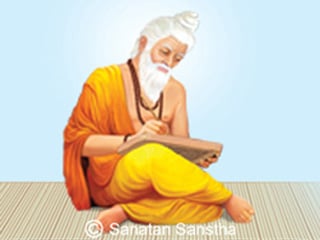
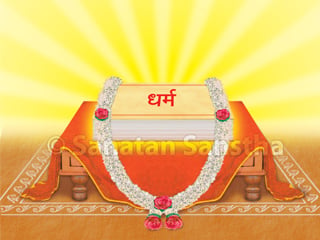 What is the true meaning of word Dharma (Righteousness) ?
What is the true meaning of word Dharma (Righteousness) ?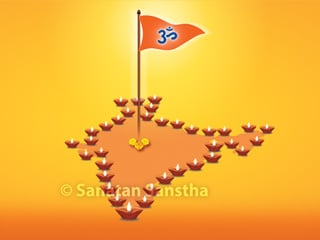 Dharma (Righteousness) and the importance of India (Bharat)
Dharma (Righteousness) and the importance of India (Bharat)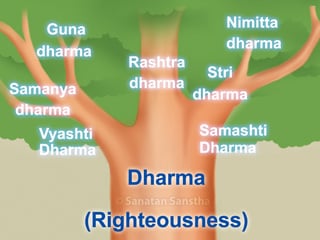 Types of Dharma (Righteousness)
Types of Dharma (Righteousness)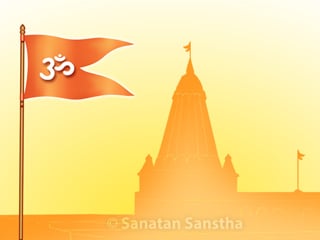 Hindu Dharma
Hindu Dharma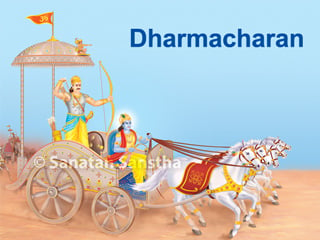 Why is it essential to adhere to Righteousness (Living Dharma) ?
Why is it essential to adhere to Righteousness (Living Dharma) ?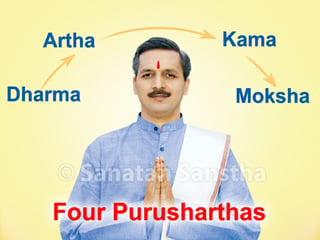 Dharmasiddhant - Principles of Hinduism (Doctrines of Dharma [Righteousness] )
Dharmasiddhant - Principles of Hinduism (Doctrines of Dharma [Righteousness] )